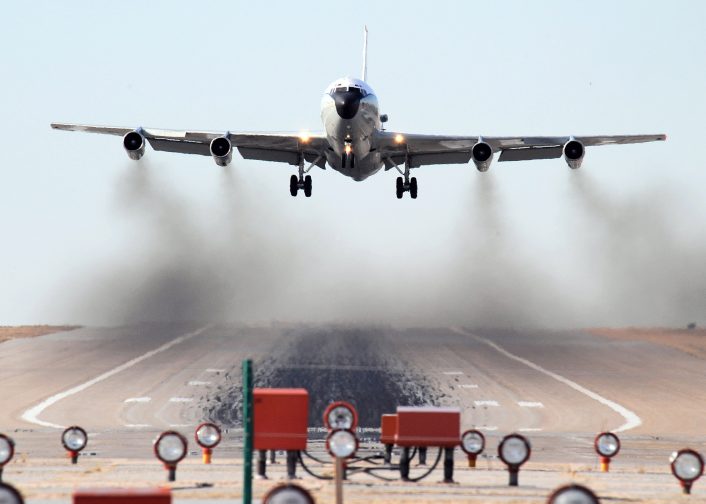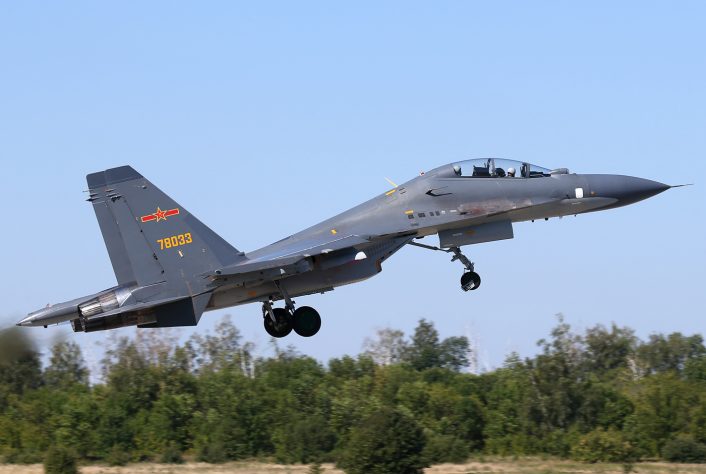A Chinese fighter pilot performed a Top Gun stunt over a U.S. Air Force WC-135.
On May 17, a Chinese Su-30 Flanker rolled over the top of a U.S. Air Force WC-135C Constant Phoenix aircraft which was flying in international airspace above the East China Sea.
According to the CNN the Flanker belonged to a formation of two Chinese Su-30s that intercepted the WC-135 nuclear sniffer aircraft involved in a a routine mission in Northeast Asia.
The aircraft came within 150 feet of the WC-135 with one of the Su-30s flying inverted, directly above the American “nuke hunter” plane, in a stunt that was made famous by Top Gun movie.
“While we are still investigating the incident, initial reports from the U.S. aircrew characterized the intercept as unprofessional, ” said Air Force Lt. Col. Hodge in a statement.
The WC-135 Constant Phoenix aircraft is a Boeing C-135 transport and support plane derivative belonging to the 45th Reconnaissance Squadron from Offutt Air Force Base (with mission crews staffed by Detachment 1 from the Air Force Technical Applications Center) that is able to collect and analyze the fallout residue in real-time, helping to confirm the presence of nuclear fallout and possibly determine the characteristics of the warhead involved.
The aircraft has recently deployed to Kadena Air Base, Okinawa, Japan, close to the Korean peninsula, to monitor North Korea’s nuke weapons tests.

Not the first time
This is not the first time a Chinese or Russian fighter pilot performs a Top Gun-like stunt or aggressively maneuvers close to a U.S. aircraft.
In February 2017, a People’s Liberation Army Air Force KJ-200 and a U.S. Navy P-3 Orion aircraft were involved in what was defined by U.S. officials as an “unsafe” close encounter over the South China Sea.
Last year, on Apr. 29, 2016, a Russian Su-27 Flanker barrel rolled over the top of a U.S. Air Force RC-135 aircraft operating in the Baltic Sea. The Russian jet came within 25 feet of the U.S. intelligence gathering aircraft.
Another Su-27 had carried out the same dangerous maneuver on another US Rivet Joint over the Baltic on Apr. 14, 2016.
Previously, on Jan. 25, 2016 another U.S. RC-135 intelligence gathering jet was intercepted over the Black Sea by a Russian Su-27 Flanker that made an aggressive turn that disturbed the controllability of the RC-135.
On Apr. 7, 2015 another Su-27 flew within 20 feet of an RC-135U over the Baltic Sea.
On Apr. 23, 2015 a U.S. Air Force RC-135U Combat Sent performing a routine surveillance mission in international airspace over the Sea of Okhotsk, north of Japan, some 60 miles off eastern Russia was intercepted by a Russian Su-27 Flanker that crossed the route of the U.S. aircraft putting itself within 100 feet of the Combat Sent.
In 2014, a Chinese Flanker made a barrel roll over a U.S. Navy P-8 maritime surveillance plane 135 miles east of Hainan Island, a spot where a dangerous close encounter of another U.S. electronic surveillance plane with the Chinese Navy took place back in 2001: on Apr. 1, 2001, a U.S. Navy EP-3E with the VQ-1, flying an ELINT (Electronic Intelligence) mission in international airspace 64 miles southeast of the island of Hainan was intercepted by two PLAN (People’s Liberation Army Navy) J-8 fighters. One of the J-8s piloted by Lt. Cdr. Wang Wei, made two close passes to the EP-3 before colliding with the spyplane on the third pass. As a consequence, the J-8 broke into two pieces and crashed into the sea causing the death of the pilot, whereas the EP-3, severely damaged, performed an unauthorized landing at China’s Lingshui airfield.
The 24 crew members (21 men and three women), that destroyed all (or at least most of ) the sensitive items and data on board the aircraft, were detained by Chinese authorities until Apr. 11.










